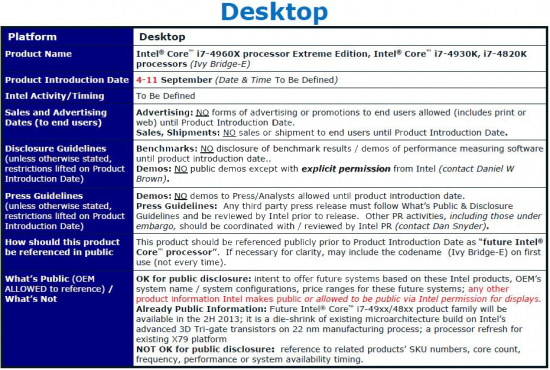Rumors on Ivy Bridge-E: 3 SKUs, September Release?
by Ian Cutress on June 20, 2013 6:51 AM EST- Posted in
- CPUs
- Ivy Bridge-E
A performance enthusiast always wants to know what is coming next. This morning HardwareLuxx published a rather interesting and official looking Intel slide detailing information about the upcoming enthusiast platform, Ivy Bridge-E. While we cannot confirm the legitimacy of the slide, it does follow several patterns we had been assuming for a while.
Firstly the launch date is a little surprising. Initially we have all been discussing October/November, but this slide puts the launch squarely at the beginning of September, between the 4th and the 11th. This is around the same date as IDF San Francisco, held on the 10-12th September.

As with previous launches, there will be a strict NDA date for media to publish results and demonstrations. Judging by what is written there does not seem to be much room for an upgrade to new chipsets, meaning that X79 is still the platform of choice at this time. I would not mind seeing an X89 with a full set of SATA 6 Gbps and USB 3.0 in the near future.
Alongside release details, CPU-World has posted information on the processor SKUs which are expected to be released. The top SKU is to be an i7-4960X, featuring 6 cores (12 threads) at 3.6 GHz which turbos up to 4 GHz and a total of 15MB L3 cache. This is going to be our top end SKU, which normally retails for $999-$1099. Below this is the i7-4930K, also 6 cores (12 threads) but set at 3.4 GHz with turbo up to 3.9 GHz and 12MB L3 cache. The final SKU should be the more interesting – the i7-4820K. The –K moniker suggests this part is unlocked, but unfortunately it is only a quad core (8 threads) part with 10MB L3 cache.
| Ivy Bridge-E SKUs (predicted) | |||||
|---|---|---|---|---|---|
| SKU | Cores / Threads | Speed / Turbo | L3 Cache | TDP | Memory |
| i7-4820K | 4/8 | 3.7 GHz / 3.9 GHz | 10 MB | 130 W | DDR3-1866 |
| i7-4930K | 6/12 | 3.4 GHz / 3.9 GHz | 12 MB | 130 W | DDR3-1866 |
| i7-4960X | 6/12 | 3.6 GHz / 4.0 GHz | 15 MB | 130 W | DDR3-1866 |
One of the main benefits of Nehalem but a big issue with Sandy Bridge-E was the lack of a cheap overclocking SKU – while the i7-920 had big success, the i7-3820 eventually came along but it was not enough. This Ivy Bridge-E low end SKU is going to be directly compared with the i7-4770K Haswell SKU, and the only thing going for it is the quad channel memory support, as it loses at IPC. All three IVB-E CPUs should come in at 130W TDP, and as an overclocker I am hoping that the Ivy Bridge overheating issues are sorted with the IVB-E processors.
Source: HardwareLUXX, CPU-World










48 Comments
View All Comments
Hixbot - Monday, July 1, 2013 - link
Yeah without a core count increase, we better see some impressive IPC gains over Sandy-e.BlackDragon24 - Thursday, June 20, 2013 - link
My 970 running at 4.0ghz is looking like it will last awhile....coldpower27 - Friday, June 21, 2013 - link
Yeah I still have the "old" Core i7 970. No need to consider upgrading till Haswell-E it seems.Ktracho - Friday, June 21, 2013 - link
What I'd like to know is to whom will Haswell-E appeal, given that other than graphics, Haswell is not much faster than Ivy Bridge? As for Ivy Bridge-E vs. Sandy Bridge-E, I imagine it will be primarily appealing for workstation/server applications, unless they update the chipset.wallysb01 - Saturday, July 6, 2013 - link
The "E" processors don't have integrated graphics. These are basically the Xeon E5-16xx-s. So the appeal is that none of the silicon is going to the GPU, just the CPU, allowing for more cores and better cores. Plus, Haswell E will probably see 8 or 10 cores. Ivy Bridge E5-2600s are going to get up to 12 now.psyq321 - Thursday, July 4, 2013 - link
It is a sad state of affairs that there is simply no application demand on the High-End Desktop (HEDT) so Intel can safely sell castrated and rejected 10-core Xeon E5 2600 v2 dies as 6-core Ivy Bridge E SKUs...With Sandy Bridge EP, the difference was not that big - 6 cores HEDT vs. 8 cores Xeon WS/Server.
However, with Ivy Bridge EP, Xeon line will be getting up to 12 cores (15 with slightly different socket but still 2011 pins), while "high end desktop" still gets only 6 cores.
I am sure if things were different in the application world and if we had today "killer apps" for desktop that are highly threaded, that we would be running 15 cores on LGA 2011 today (which is now exclusive for Ivy Bridge EX)
Instead, we still have tons of single-threaded applications where it matters more to have less cores but with higher frequency. I suppose this is also why Intel is pursuing this strategy for the high-end desktop SKUs. If they went for more cores but with lower max frequency, some desktop benchmarks would not look as good.
adamdz - Sunday, July 21, 2013 - link
I'm trying to find a good excuse to upgrade my 4.5GHz overclocked 2700K and I still haven't found any. This is really sad. We need some real competition from AMD here. The only compelling features of the Haswell desktop platform is the larger number of SATAIII ports and native USB3 support, but not the speed. And both E lines have outdated chipset:(black_plague815 - Friday, September 6, 2013 - link
Still running 980X @4.7ghz, still kills everything out except socket 2011 hex's, no reason for upgrade yet.